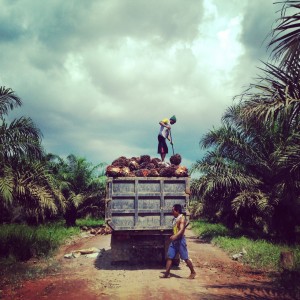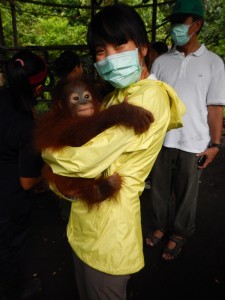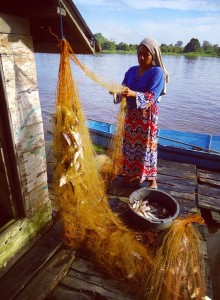
The suffocating humidity, the unrelenting mosquitoes, the smell of gasoline on the river— oh, the familiar welcome of the tropical rainforest. After wanting to visit Borneo’s rainforests since forever, I finally find myself here, in Central Kalimantan. I was pleasantly surprised to discover on my first day that Central Kalimantan (Kalteng, in abbreviated Indonesian) is home to the highest density of the endangered Borneo Orangutan. These primates, whom I fear and adore for their frighteningly human-like features and behavior, are the focus of conservationists in the region. As our boat speeds along, I am educated about the predominance of peat swamp forests in this region— waterlogged, extremely carbon-rich forest high in organic matter— that stain the river a “Coca-Cola” brown, as the locals describe it.
Kalteng is troubled, or some say blessed, by the constant and rapid expansion of palm oil on its soil. This is not unlike what is occurring in the rest of Kalimantan and Sumatra, and unsurprisingly so— the global demand for palm oil is increasing and Indonesia is cashing in as the world’s largest producer of the commodity. The conversion of natural (most often peat swamp) forest into neat, uniform rows and columns of the mono-crop is a major climate concern. Peatlands contain over ten times more carbon than the humid tropics, meaning there is massive carbon loss when it is drained and burnt. Peatlands are significant for climate: the degradation of peat is behind 80% of land use change-related carbon emissions in Indonesia; Indonesia has one of the highest deforestation rates in the world, while forest and land use change emissions account for about 15% of global emissions. But climate is not the only concern.

I got to spend some time with communities along the Seruyan river who have experienced the direct impacts of palm oil development. Along the boardwalk, villagers hang-dry their nets that have not brought home fish as they did before. Fishermen since generations past, Seruyan men and women have been forced to abandon life on the river to work on the plantations that have emerged in their backyards. In Ulak Batu, the young, shy village head lamented the cut in income they’ve had to suffer as a result of this shift. As a fisherman, he said, he brought in about 100,000 rp a day (about $8), but as a menial laborer on the plantation, he takes home only 59,000 rp ($4.90)—and the work is much tougher. Villagers also described the decline in fish stock, which they posit is a result of the pollutant fertilizers applied to expedite palm oil growth. The head of the Muara Dua village, a charismatic elderly gentleman with a wide smile, said that they fear they will not only lose their traditional way of life, but that finding food will become a problem for communities who are largely reliant on a seafood diet.
Yet another victim of palm oil expansion is the endemic Borneo orangutan. I got to visit the Orangutan Care Center and Quarantine in the town of Pangkalan Bun, managed by Dr. Birute Galdikas—one of the so-called “trimates” alongside Jane Gooddall and Diane Fosse, rounding up the female trio that has dedicated their lives to primate conservation. The rehabilitation center currently houses 330 individual orangutans, mostly adults and orphans rescued from forest that had been cleared for palm oil. Injured orangutans are nursed back to health before they are set free in release camps in the rainforest, including one within the Rimba Raya Biodiversity Reserve.

Climate, community, biodiversity. This is the mantra behind the Rimba Raya REDD+ project, which seeks to Reduce Emissions from Deforestation and forest Degradation (REDD) by creating a protected Reserve. The value of Rimba Raya is in the high conversion risk its forests face: the land on which the Reserve sits had been given in concessions to palm oil companies, but has now acquired an Ecosystem Restoration permit from the government, protecting it for 30 renewable years. The Reserve protects about 60,000 hectares of mostly peat forest, sequestrating about 4 million tonnes of carbon a year. Rescued orangutans will find new homes in these forests. Neighboring Seruyan villages are receiving water filters and cookstoves, and will set up agricultural field schools with support from the Rimba Raya project. Later on, I will be exploring what the villages perceive of the project.
REDD+ is about increasing the value— all kinds, for all stakeholders— of the forest, such that the opportunity cost of conserving it is lower than that of cutting it down. While that remains to be seen for Rimba Raya, the project could provide a means of finance to preserve the integrity and multiple values of the forest for all who have a stake in it. The REDD+ debate goes on, even as projects such as Rimba Raya continue in the strive to be the model REDD+ project that the world has been scrambling for.

The challenge for the project now is to find buyers for the carbon credits it generates. Potential buyers from a large Japanese cooperative who I met said they liked how each credit they buy represents not just carbon, but also co-benefits for people and the (very charismatic) orangutan, an important umbrella species in Kalimantan’s peat forests.
For now, I’m working on the carbon audit for Rimba Raya, mapping communities and palm oil encroachment, and asking questions about the true benefits for the communities of Seruyan. Rimba Raya has also taken me to Bali and Jakarta, where I have gotten to connect with F&ES alumni. Later, I will be at the Center for International Forestry Research (CIFOR) in Bogor to research palm oil sustainability in Brazil and Indonesia. Stay tuned!
Edited by David Gonzalez